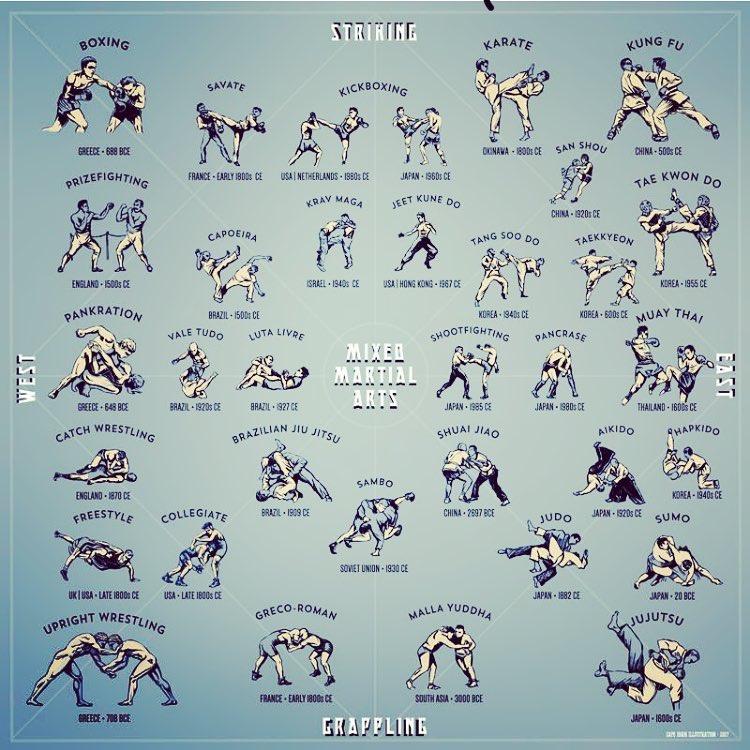The Development And Progression Of Martial Arts: Tracing Its Origins From Ancient Times To Contemporary Practices
The Development And Progression Of Martial Arts: Tracing Its Origins From Ancient Times To Contemporary Practices
Blog Article
Web Content Author-Clemons Ross
Enter the world of martial arts, where old origins and modern-day techniques clash in an exhilarating trip of discipline and self-discovery.
As you explore the history and advancement of this captivating art type, prepare to be mesmerized by the social influences, technological improvements, and extensive ideology that have formed it over centuries.
From the field of battles of ancient civilizations to the training grounds these days, martial arts have stood the test of time, continuously adjusting and growing.
Each strike, each movement, carries with it the weight of many years of custom and wisdom, passed down with generations. This is a tale of durability, of warriors that sought not only physical expertise, but also inner strength and harmony.
Join us on this exceptional expedition as we reveal the secrets, the legends, and the transformational power of martial arts.
Get ready to be motivated, tested, and permanently changed by the history and development of martial arts.
Cultural Influences on Martial Arts
As you discover the history and evolution of martial arts, you'll quickly uncover the interesting methods which social impacts have formed these battle techniques.
From the ancient people of China and India to the a lot more current developments in Japan and Brazil, martial arts have actually been heavily influenced by the societies in which they stemmed.
As an example, Chinese martial arts, such as Kung Fu and Tai Chi, are deeply rooted in the philosophy of Taoism and the concept of Yin and Yang.
In contrast, Japanese martial arts, like Martial arts and Judo, reflect the samurai warrior traditions and the values of self-control and honor.
Similarly, Brazilian fighting style, Capoeira, incorporates aspects of African dance and songs, showing the social heritage of African servants in Brazil.
These social influences not just provide each fighting style its special characteristics however likewise supply a much deeper understanding of the historical and social contexts in which they progressed.
Technical Advancements and Martial Arts
With the rise of advanced weaponry and innovative training devices, you've had the ability to enhance your abilities and adjust to the ever-changing combat landscape.
Technological developments have actually revolutionized the method martial arts are practiced and shown. Virtual reality simulations now allow you to learn reasonable battle scenarios without the danger of physical injury. High-speed cameras record every move, enabling you to assess and excellent your methods. related web-site check your heart rate, breathing, and muscular tissue activation, giving instantaneous responses on your performance.
In addition, the development of customized equipment, such as resistance bands and dexterity ladders, has actually enabled you to enhance your speed, toughness, and agility. These technical advancements have not only made training extra effective but have also pushed the boundaries of what is possible in martial arts, allowing you to get to brand-new heights in your method.
The Approach and Principles of Martial Arts
The ideology and principles of martial arts are deeply rooted fit your state of mind and instilling discipline, emphasis, and respect in your practice.
1. Attitude: Martial Arts instructs you to create a strong and durable mindset. It enables you to overcome challenges both on and off the floor covering, pressing your limitations and being determined when faced with adversity.
2. Self-control: Martial Arts demands technique and self-control. Through regular training and adherence to strict rules and techniques, you learn to control your impulses and create a strong job principles.
3. Emphasis: Martial Arts calls for extreme emphasis and concentration. By training your mind to be existing in the minute, you boost your capability to respond rapidly and efficiently during battle situations.
4. Respect: Martial Arts emphasizes respect for oneself, instructors, educating companions, and opponents. It instructs you to value the skills and experiences of others, fostering a feeling of sociability and sportsmanship.
Final thought
Congratulations on completing your journey through the captivating globe of martial arts! Throughout this expedition, you have actually witnessed the abundant history and exceptional evolution of these combat practices.
From what age to start kids in martial arts to the modern-day techniques we see today, martial arts have actually been formed by cultural influences.
The combination of technology has also played a significant role in reinventing the method martial arts are instructed and practiced in the present day.
However, it is important to keep in mind that martial arts are more than simply physical battle. They incorporate profound approaches and assisting concepts that surpass the mere act of combating.
Take a moment to assess this anachronistic adventure and appreciate how the tradition of martial arts remains to thrive in the here and now, transcending time and boundaries.
